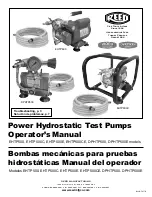
14
3.1
OPERATING CONDITIONS
-
Power supply voltage: SINGLE-PHASE and THREE-PHASE as indicated on the plate. Max permissible variation:± 10% of
ratings stated on the data plate.
-
Pump immersion depth: Max. depth 30 metres below liquid level.
-
Liquid temperature: Maximum temperature of motor-driven pumped liquid: 40 °C.
-
Maximum permissible number of starts per hour: 20 for up to 4 kW power 15 for 4 to 7.4 kW; 10 for 7.5 to 45 kW; 5 for over 45
kW; at regular intervals in all cases.
To prevent the entrainment of air caused by turbulence of the flow, and consequent malfunctioning of the electric pump, ENSURE
that the liquid does not fall directly onto the inlet, and that the inlet is sufficiently submerged to prevent the formation of vortices.
Wells and collection tanks: The dimensions of wells and tanks should be sufficient to avoid an excessive number of start-ups per
hour.
For submersible electric pumps not equipped with cooling jackets the level of the liquid must never fall below the cover of the
electric pump’s motor.
-
Protection rating: IP 68
-
Field of application: drainage and/or transfer of sewage.
-
Field of application: sewage from cesspools and drainage in areas where EXPLOSIVE GASES AND DUSTS are present (-EX)
-
Service factor: S1 for fully submerged electric pumps, S3 with the percentage indicated on the adhesive metal plate, for partially
submerged electric pumps.
The explosion-proof versions, indicated by the initials -EX, are APPROVED in compliance with the explosion-proof protection
requirements stated in point 2.1 (standards EN 60079-0, EN 60079-1, EN 1127-1, EN 13463-1, EN 13463-5, EN 13463-8, EN
61241-0) for operation in wells and tanks where EXPLOSIVE GASES AND DUSTS are present and, in any case, in areas
classified as zones 1 or 21. WARNING: any maintenance operation that modifies the components of the electric pump can
result in a serious RISK of EXPLOSION. These pumps MUST be used ONLY in environments mentioned in the above
explosion-proof protection category.
Make sure that the electric pump is not operated outside its characteristic curve.
These electric pumps are not suitable for manipulating liquids for nutritional use.
These electric pumps may not be used in tanks or other locations in which the machine may come into contact with parts of
the body.
The pumps can operate in a continuous cycle S1 below the liquid level, or in a discontinuous cycle S3 (25%) with only the
hydraulic part immerged in the liquid.
3.2 LIQUIDS TREATED
These are liquids containing small and medium/sized solid particles, filamentary particles etc and generally drainage liquids,
sewage, purification waters, and those resulting from by civil and industrial processes.
Suitable for environments containing group II A and/or II B gases (regular hydrocarbon gases).
Also suitable for environments containing fuel/dust mixtures with ignition temperatures above 100°C
3.3 NOISE LEVEL
Submersible electric pumps present acoustic pressure levels of less than 70 dB (A) when immersed and in any case less than 80
dB if installed dry.
4 INSTALLATION
4.1 SHIPPING
Before installation, read and apply the safety procedures in paragraphs 1.2 and 1.3 carefully
Mass according to table 1 - 1/a - 1/b.
For electric pumps weighing 30 kg or less moving and lifting may be performed manually using the handle fitted on the upper part of
the electric pump. Electric pumps weighing 30 kg or more must be moved or lifted using a suitable mechanical device according to
the weight of the electric pump.
NEVER use the power cable or float cable to lift and move the unit. Use the appropriate handle or lifting eyelet.
Carry out a visual inspection of the packing and its contents to ensure that no damage has occurred. If there is any sign of
significant damage, contact ZENIT without delay.
Check that the specifications indicated on the data plate are as required.
Before making any power connections or installing the electric pump, turn the shaft with the relative wrench to ensure that it rotates
freely.
4.2 PLACEMENT
Before installation, read and apply the safety procedures in paragraphs 1.2 and 1.3 carefully.
The electric pump installation and wiring-up operations must be carried out by a skilled technician
as outlined in chapter 1.
Always check that the electric pump is not connected to the electricity supply before performing any operations on it.
Summary of Contents for GRS Series
Page 2: ......
Page 69: ...67 Fig 2 a GRI 200 2 G50H A0CM T E...
Page 74: ...72...
Page 75: ......
Page 78: ......
Page 79: ...1 ITALIANO 2 ENGLISH 11 FRANCAIS 19 DEUTSCH 28 ESPANOL 37...
Page 134: ...56...
Page 135: ......
Page 138: ......
Page 165: ...29 1 4 3 1 1 1 1 2 KANONI 50 C GRT GRN GRP 1 3 DPI 2 3 EN GJL 250 EN GJL 250 UNI 1561 1563...
Page 167: ...31 4 2 1 1 4 2 2 4 3 8 8 1 2 1 3 1 4 4...
Page 169: ...33 6 EX zenit 7 8 8 1 3 4 8 2 3 6 3 U V W 6 U1 U2 V1 V2 W1 W2 5 6 8 3 8 4 S...
Page 217: ......
Page 218: ...Cod 272701002830000000 Rev 4 01 06 11 www zenit com...
















































